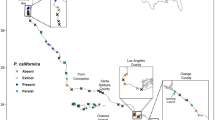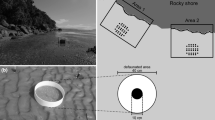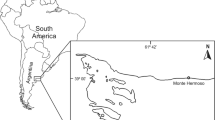Summary
The stability of a high rocky intertidal community was assessed in a controlled field experiment in which the most common consumers, limpets, were temporarily removed. Compared to the unmanipulated plots, the exclusion plots developed greater algal abundance and altered species composition of both algae and barnacles. The community was not perturbed beyond its capacity to recover, since the community structure of the limpet-removal plots converged on the structure of the unmanipulated plots following limpet reintroduction. Different components of the community recovered at different rates, depending on whether or not the species had a size-related escape from the limpets. Algae had no size-related escape from limpets. The difference in algal abundance between manipulated and unmanipulated plots lasted less than six months after limpet reintroduction. Barnacles, however, had a size-related escape from limpets and therefore recovered more slowly. The difference in barnacle species composition between the perturbed and unperturbed plots lasted for 17 months after limpet reintroduction. The length of the limpet removal period (16 or 28 months) did not appear to affect the rate of community recovery.
Similar content being viewed by others
References
Abbott IA, Hollenberg GJ (1976) Marine algae of California. Stanford University Press, California
Beddington JR, May RM (1982) The harvesting of interacting species in a natural ecosystem. Sci Am 247:62–69
Boag PT, Grant PR (1981) Intense natural selection on a population of Darwin's finches (Geospizinae) in the Galapagos. Science 214:82–85
Boesch DF (1974) Diversity, stability and response to human disturbance in estuarine ecosystems. In: Structure, functioning and management of ecosystems. Proc First Int Congr Ecol, PUDOC, Wageningen, pp 109–114
Bold HC, Wynne MJ (1978) Introduction to the algae. Prentice-Hall, New Jersey
Branch GM (1981) The biology of limpets: physical factors, energy flow and ecological interactions. Oceanogr Mar Biol Ann Rev 19:235–379
Branch GM (1986) Limpets: their role in littoral and sublittoral community dynamics. In: Moore PG, Seed R (eds) The ecology of rocky coasts. Columbia University Press, New York, pp 97–116
Castenholz RW (1961) The effect of grazing on marine littoral diatom populations. Ecology 42:783–794
Clayton MN (1981) Experimental analysis of the life history of the complanate form of Scytosiphon (Scytosiphonaceae, Phaeophyta) in southern Australia. Phycologia 20:358–364
Connell JH, Sousa WP (1983) On the evidence needed to judge ecological stability or persistence. Am Nat 122:661–696
Cubit JD (1975) Interactions of seasonally changing physical factors and grazing affecting high intertidal communities on a rocky shore. PhD thesis. University of Oregon, Eugene
Cubit JD (1984) Herbivory and the seasonal abundance of algae on a high rocky intertidal shore. Ecology 65:1904–1917
Dayton PK (1971) Competition, disturbance and community organization: the provision and subsequent utilization of space in a rocky intertidal community. Ecol Monogr 41:351–389
Denley EJ, Underwood AJ (1979) Experiments on factors influencing settlement, survival and growth of two species of barnacles in New South Wales. J Exp Mar Biol Ecol 36:269–293
Dungan ML, Miller TE, Thomson DA (1982) Catastrophic decline of a top carnivore in the Gulf of California rocky intertidal zone. Science 216:989–991
Frank PW (1965) The biodemography of an intertidal snail population. Ecology 46:831–844
Frank PW (1982) Effects of winter feeding on limpets by black oystercatchers Haematopus bachmani. Ecology 63:1352–1362
Gaines S, Brown S, Roughgarden J (1985) Spatial variation in larval concentrations as a cause of spatial variation for the barnacle, Balanus glandula. Oecologia (Berlin) 67:267–272
Harris LG, Ebeling AW, Laur DR, Rowley RJ (1984) Community recovery after storm damage: a case of facilitation in primary succession. Science 224:1336–1338
Hawkins SJ, Hartnoll RG (1983) Grazing of intertidal algae by marine invertebrates. Oceanogr Mar Biol Ann Rev 21:195–282
Jernakoff P (1983) Factors affecting the recruitment of algae in a midshore region dominated by barnacles. J Exp Mar Biol Ecol 67:17–31
Jernakoff P (1985) The effect of overgrowth by algae on the survival of the intertidal barnacle Tesseropora rosea Krauss. J Exp Mar Biol Ecol 94:89–97
Keith LB (1983) Role of food in hare population cycles. Oikos 40:385–395
Kim DH (1976) A study of the development of cystocarps and tetrasporangial sori in Gigartinaceae (Rhodophyta, Gigartinales). Nova Hedwigia 27:1–145
Krebs CJ, Gaines MS, Keller BL, Myers JM, Tamarin RH (1973) Population cycles in small rodents. Science 179:35–41
Lamberti GA, Resh VH (1983) Stream periphyton and insect herbivores: an experimental study of grazing by a caddisfly population. Ecology 64:1124–1135
Lindberg DR (1986) Name changes in the “Acmaeidae”. The Veliger 29:142–148
Little C, Smith LP (1980) Vertical zonation on rocky shores in the Severn Estuary. Estuar Cstl Mar Sci 11:651–669
Lubchenco J (1983) Littorina and Fucus: effects of herbivores, substratum heterogeneity, and plant escapes during succession. Ecology 64:1116–1123
Lubchenco J, Cubit JD (1980) Heteromorphic life histories of certain marine algae as adaptations to variations in herbivory. Ecology 61:676–687
Lubchenco J, Gaines SD (1981) A unified approach to marine plant-herbivore interactions. 1. Populations and communities. Ann Rev Ecol Syst 12:405–437
Marsh CP (1986) Impact of avian predators on high intertidal limpet populations. J Exp Mar Biol Ecol 67:276–280
Menge BA (1979) Coexistence between the seastars Asterias vulgaris and A. forbesi in a heterogeneous environment: a non-equilibrium explanation. Oecologia (Berlin) 41:245–272
Menge BA, Lubchenco J (1981) Community organization in temperate and tropical rocky intertidal habitats: prey refuges in relation to consumer pressure gradients. Ecol Monogr 51:429–450
Nicotri ME (1977) Grazing effects of four marine intertidal herbivores on the microflora. Ecology 58:1020–1032
Orians GH (1974) Diversity, stability and maturity in natural ecosystems. In: van Dobben WH, Lowe-McConnell RH (eds) Unifying concepts in ecology. Junk, The Hague, pp 139–150
Paine RT (1976) Size-limited predation: an observational and experimental approach with the Mytilus-Pisaster interaction. Ecology 57:858–873
Paine RT (1980) Food webs: linkage, interaction strength and community infrastructure. J Anim Ecol 49:667–685
Paine RT (1981) Barnacle ecology: is competition important? The forgotten roles of predation and disturbance. Paleobiology 7:553–560
Paine RT (1984) Ecological determinism in the competition for space. Ecology 65:1339–1348
Paine RT, Castilla JC, Cancino J (1985) Perturbation and recovery patterns in starfish dominated intertidal assemblages in Chile, New Zealand, and Washington State. Am Nat 125:679–691
Petraitis PS (1983) Grazing patterns of the periwinkle and their effect on sessile intertidal organisms. Ecology 64:522–533
Potts GR, Tapper SC, Hudson PJ (1984) Population fluctuations in red grouse: analysis of bag records and a simulation model. J Anim Ecol 53:21–36
Ricketts EF, Calvin J (1968) Between Pacific tides 4th ed. Revised by Hedgpeth JW. Stanford University Press, California
Robles C (1982) Disturbance and predation in an assemblage of herbivorous diptera and algae on rocky shores. Oecologia (Berlin) 54:23–31
Robles CD, Cubit JD (1981) The influence of biotic factors in an upper intertidal community: dipteran larvae grazing on algae. Ecology 62:1536–1547
Roeleveld JG, Duisterhof M, Vroman M (1974) On the year cycle of Petalonia fascia in the Netherlands. Neth J Sea Res 8:410–426
Scheibling R (1986) Increased macroalgal abundance following mass mortality of sea urchins (Strongylocentrotus droebachiensis) along the Atlantic coast of Nova Scotia. Oecologia (Berlin) 68:186–198
Sebens KP (1986) Community ecology of vertical rock walls in the Gulf of Maine, USA: small scale processes and alternative community states. In: Moore PG, Seed R (eds) The ecology of rocky coasts. Columbia University Press, New York, pp 346–371
Sebens KP, Lewis JR (1985) Rare events and population structure of the barnacle Semibalanus cariosus (Pallas 1788). J Exp Mar Biol Ecol 87:55–65
Sih A, Crowley P, McPeek M, Petranka J, Strohmeier K (1985) Predation, competition and prey communities: a review of field experiments. Ann Rev Ecol Syst 16:269–312
Simenstad CA, Estes JA, Kenyon KK (1978) Aluets, sea otters, and alternative stable state communities. Science 200:403–411
Slocum CJ (1980) Differential susceptibility to grazers in two phases of an intertidal alga: advantages of heteromorphic generations. J Exp Mar Biol Ecol 46:99–110
Snavely PD, Macleod NS (1971) Visitor's guide to the geology of the coastal area near Beverly Beach State Park, Oregon. Ore Bin 33:85–105
Sokal RR, Rohlf FJ (1981) Biometry. WH Freeman and Company, New York
Sousa WP (1979) Experimental investigations of disturbance and ecological succession in a rocky intertidal algal community. Ecol Monogr 49:227–254
Sousa WP (1980) The responses of a community to disturbance: the importance of successional age and species' life histories. Oecologia (Berlin) 45:72–81
Sousa WP (1984) Intertidal mosaics: patch size, propagule availability, and spatially variable patterns of succession. Ecology 65:1918–1935
Southward AJ, Southward EC (1978) Recolonisation of rocky shores in Cornwall after use of toxic dispersants to clean up the Torrey Canyon spill. J Fish Res Bd Can 35:682–706
Stafford J (1971) Heron populations of England and Wales 1928–70. Bird Study 18:218–221
Sutherland JP (1970) Dynamics of high and low populations of the limpet Acmaea scabra (Gould). Ecol Monogr 40:169–188
Wiens JA, Addicott JF, Case TJ, Diamond J (1986) Overview: the importance of spatial and temporal scale in ecological investigations. In: Diamond J, Case TJ (eds) Community Ecology. Harper & Row, New York, pp 145–153
Author information
Authors and Affiliations
Rights and permissions
About this article
Cite this article
Farrell, T.M. Community stability: effects of limpet removal and reintroduction in a rocky intertidal community. Oecologia 75, 190–197 (1988). https://doi.org/10.1007/BF00378596
Received:
Issue Date:
DOI: https://doi.org/10.1007/BF00378596




